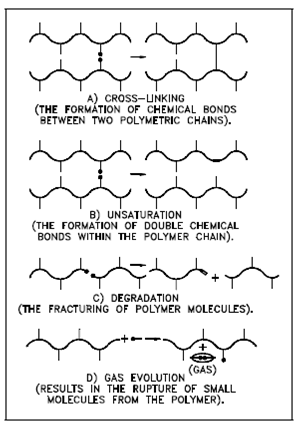Plastics, Elastomers, and oils:
Organics are simply permeated through tritium (gas or water) and are thus subject to disruption of their bulk chemistries. Those are some or no mechanisms for rapidly delocalizing beta energy and substantial mobility of organic chains occur inside polymer structures (particularly amorphous regions). At one it formed, reactive organic intermediates could therefore react along with each other.
These effects are important while considering the design of tritium systems. Damage to elements, like as gaskets, valve tips, and O-rings, must be carefully considered. A Component failure during service could cause a main release of tritium. Since elastomer seals frequent become embrittled, manages on nearby sections of piping might cause seals to establish leaks as the result of mechanical movement in the seal area.

Figure 1 illustrates several polymer chain modifications that take place following activation by beta radiation to ionic or excited species. Cross-linking and degradation are the most important processes to the mechanical properties of the polymer. These both compete in a material, but those polymers that are most sterically hindered appear to preferentially degrade. The Steric hindrance avoids neighboring chains from connecting and also imparts structural strains which are relieved upon chain scissioning. A Cross- linking is noted mechanically through an increase in tensile strength and a decrease in elongation, whereas degradation is evidenced through a decrease in tensile strength, a raise in elongation, and softening of the polymer to a gummy consistency.